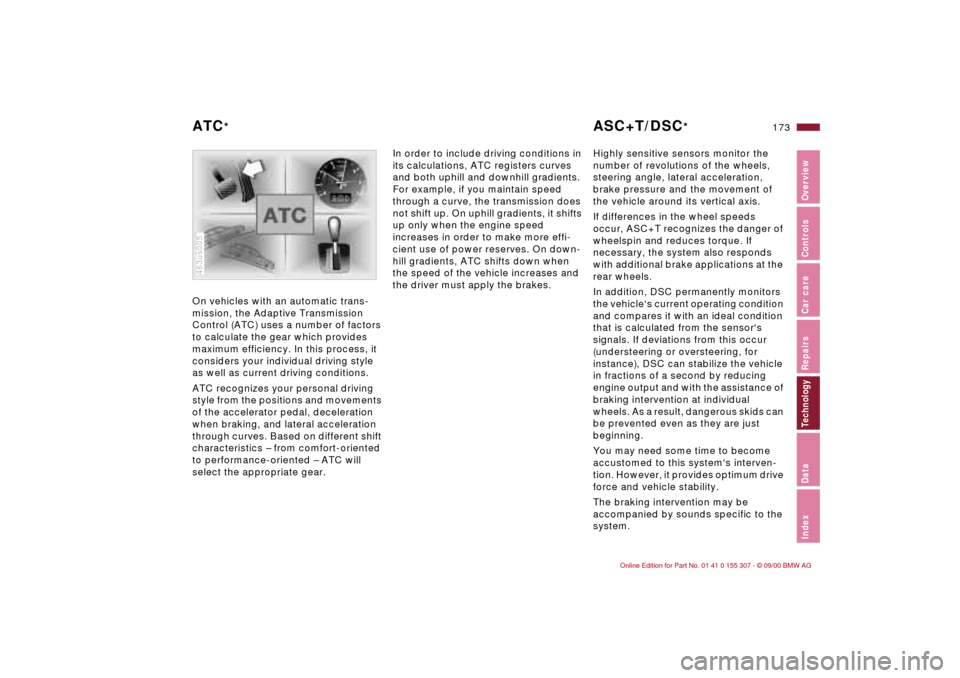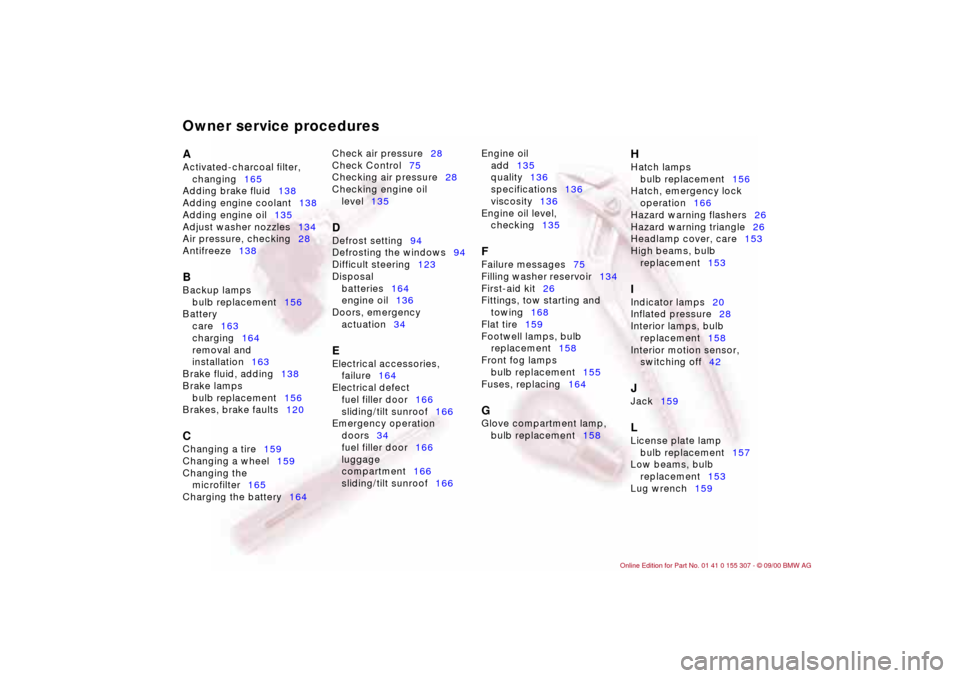Page 173 of 203

173n
IndexDataTechnologyRepairsCar careControlsOverview
On vehicles with an automatic trans-
mission, the Adaptive Transmission
Control (ATC) uses a number of factors
to calculate the gear which provides
maximum efficiency. In this process, it
considers your individual driving style
as well as current driving conditions.
ATC recognizes your personal driving
style from the positions and movements
of the accelerator pedal, deceleration
when braking, and lateral acceleration
through curves. Based on different shift
characteristics Ð from comfort-oriented
to performance-oriented Ð ATC will
select the appropriate gear.463us005
In order to include driving conditions in
its calculations, ATC registers curves
and both uphill and downhill gradients.
For example, if you maintain speed
through a curve, the transmission does
not shift up. On uphill gradients, it shifts
up only when the engine speed
increases in order to make more effi-
cient use of power reserves. On down-
hill gradients, ATC shifts down when
the speed of the vehicle increases and
the driver must apply the brakes.Highly sensitive sensors monitor the
number of revolutions of the wheels,
steering angle, lateral acceleration,
brake pressure and the movement of
the vehicle around its vertical axis.
If differences in the wheel speeds
occur, ASC+T recognizes the danger of
wheelspin and reduces torque. If
necessary, the system also responds
with additional brake applications at the
rear wheels.
In addition, DSC permanently monitors
the vehicle's current operating condition
and compares it with an ideal condition
that is calculated from the sensor's
signals. If deviations from this occur
(understeering or oversteering, for
instance), DSC can stabilize the vehicle
in fractions of a second by reducing
engine output and with the assistance of
braking intervention at individual
wheels. As a result, dangerous skids can
be prevented even as they are just
beginning.
You may need some time to become
accustomed to this system's interven-
tion. However, it provides optimum drive
force and vehicle stability.
The braking intervention may be
accompanied by sounds specific to the
system.
ATC
*
ASC+T/DSC
*
Page 193 of 203

Everything from A to Z
193n
IndexDataTechnologyRepairsCar careControlsOverview
Changing a wheel159
Charge indicator lamp20
Check air pressure28
Check Control75
Check engine oil level135
Child restraint
systems54,60
Child-safety locks58
Child's seat54
Cigarette lighter104
Cleaning windshield68
Clock75
refer also to the Radio or
Computer Owner's Manual
Cockpit16
Coin holder102
Combination switch68
Compression184
Computer76
Configure settings52
Consumption77
display74
Contents10
Control elements20
Coolant121,137,187
antifreeze121
Coolant temperature
gauge74
Cooling system187
Copyright4
Cornering Brake Control
(CBC)21,117 Cruise control71
Cruising range77
Cup holder, refer to
beverage holder102
Curb weight186
Current check indicator20
D
Dashboard16
Data
dimensions185
engine184
technical184
weights186
Daytime-driving lamp
switch87
DBC (Dynamic Brake
Control)118
Defrost position94,98
Defrostable rear window99
Defrosting
rear window92
windows94,98
Digital clock75
Dimensions185
Dipstick, engine oil135
Disc brakes118
Displacement184
Display lighting87
Displays18
Distance warning78 Diversity Antenna
system174
Door key32,35
Door locks, care121
Doors
child-safety locks58
emergency operation34
unlocking and locking34
DOT Quality Grades125
Draft-free ventilation93
Drive belts188
Driving hints115
Driving in winter121
Driving lamps87
DSC (Dynamic Stability
Control)81,173
Dynamic Brake Control
(DBC)118
Dynamic Stability Control
(DSC)22,81,173
E
Electric power seat48
Electric power windows43
Electrical accessories,
failure164
Electrical system188
Electronic vehicle
immobilizer33
Elements of operation16 Emergency operation,
doors34
Energy Control73
Engine
coolant137,187
data184
starting61
Engine oil
capacity187
consumption135
pressure20
quality136
specifications136
viscosity136
Engine speed184
Exterior mirrors51
F
Failure messages75
Fault displays75
Fault, ABS117
Filler cap cover27
Filling capacities187
Filling the washer
reservoir187
First-aid kit26
Fittings, tow starting and
towing168
Flashlight101
Flat tire124,159
Fog lamps88
Page 198 of 203

Owner service proceduresA
Activated-charcoal filter,
changing165
Adding brake fluid138
Adding engine coolant138
Adding engine oil135
Adjust washer nozzles134
Air pressure, checking28
Antifreeze138 B
Backup lamps
bulb replacement156
Battery
care163
charging164
removal and
installation163
Brake fluid, adding138
Brake lamps
bulb replacement156
Brakes, brake faults120 C
Changing a tire159
Changing a wheel159
Changing the
microfilter165
Charging the battery164 Check air pressure28
Check Control75
Checking air pressure28
Checking engine oil
level135
D
Defrost setting94
Defrosting the windows94
Difficult steering123
Disposal
batteries164
engine oil136
Doors, emergency
actuation34 E
Electrical accessories,
failure164
Electrical defect
fuel filler door166
sliding/tilt sunroof166
Emergency operation
doors34
fuel filler door166
luggage
compartment166
sliding/tilt sunroof166 Engine oil
add135
quality136
specifications136
viscosity136
Engine oil level,
checking135
F
Failure messages75
Filling washer reservoir134
First-aid kit26
Fittings, tow starting and
towing168
Flat tire159
Footwell lamps, bulb
replacement158
Front fog lamps
bulb replacement155
Fuses, replacing164 G
Glove compartment lamp,
bulb replacement158
H
Hatch lamps
bulb replacement156
Hatch, emergency lock
operation166
Hazard warning flashers26
Hazard warning triangle26
Headlamp cover, care153
High beams, bulb
replacement153 I
Indicator lamps20
Inflated pressure28
Interior lamps, bulb
replacement158
Interior motion sensor,
switching off42 J
Jack159 L
License plate lamp
bulb replacement157
Low beams, bulb
replacement153
Lug wrench159